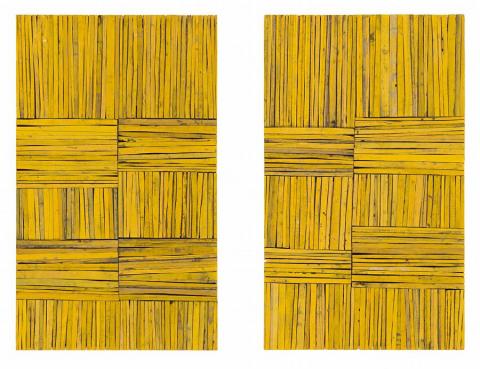STOOKS, 1991-92
ROSALIE GASCOIGNE
sawn wood on hardboard (diptych)
110.0 x 66.5 cm each
left panel signed, dated and titled verso: STOOKS I Rosalie Gascoigne 1991-92
right panel signed, dated and titled verso: STOOKS II Rosalie Gascoigne 1991-92
Pinacotheca Gallery, Melbourne
Martin Browne, Sydney
Private collection, Auckland
Rosalie Gascoigne, Pinacotheca Gallery, Melbourne, 5–22 May 1993, cat. 25
Spring Exhibition, John Leech and Gow Langsford Galleries, Auckland, 8 September – 2 October 2010, cat. 37 (illus. in exhibition catalogue)
Macdonald, V., Rosalie Gascoigne, Regaro, Sydney, 1998, p. 106
With her training in the formal discipline of Ikebana complementing her intuitive understanding of the nature of materials, her deep attachment to her environment and later interest in modern art, Rosalie Gascoigne is regarded as one of Australia's most revered assemblage artists. Bespeaking a staunchness and scrupulous eye, her compositions such as the present are artful and refined, yet always maintain a close proximity to the outside world, powerfully evoking remembered feelings or memories in relationship to the landscape; they are 'instances of emotion recollected in tranquillity' to quote a phrase of Wordsworth's which was so dear to her.
An austere and extremely sophisticated work constructed from the artist's 'signature' material, the shimmering yellow-gold Schweppes crates, Stooks I and Stooks II 1991-92 bears close affinities to her celebrated four-panel masterpiece, Monaro 1989 in the collection of the Art Gallery of Western Australia and particularly, the late work, Plenty 1996 in the National Gallery of Australia, both of which lyrically echo the billowing of sun, shadow and wind upon undulating fields of wheat. Although its title alludes to the sheaves of grain stalks typically placed upright in fields to dry, similarly the present work is by no means a literal representation; rather, it derives its strength and honesty from the artist's deft arrangement of such prosaic material, discarded long after its commercial use had expired, to embody in a partial but concrete fashion a sense of the Australian landscape.
Like the best of her work, Stooks I and Stooks II does not symbolise the landscape but 're-presents' it, each fragment of wood evoking memories and associations particular to the individual viewer. Redolent with poetic possibility, thus the composition speaks in complex terms about the construction of landscape, presenting the viewer with openings to a number of worlds and not simply the land as a kind of visual essay where form and subject correspond. As John McDonald elucidates, Gascoigne's work '...awakens associations that lie buried beneath the surface of consciousness; inviting a higher degree of sensitivity and attentiveness to the world around us.'1 Indeed, it is this higher awareness, the ability to recognise beauty in the most humble of materials that Gascoigne demands of her audience. For, as the eye moves through this skilful arrangement searching for information within the weathered components and the mind attempts to place different rules of perspective or build upon the suggestion of the marks, 'in time we realise that the only solution is to stop trying to navigate through the forest of symbols, and enjoy the beauty of the trees.'2
1. MacDonald, V., Rosalie Gascoigne, Regaro, Sydney, 1998, p. 7
2. ibid.
VERONICA ANGELATOS
